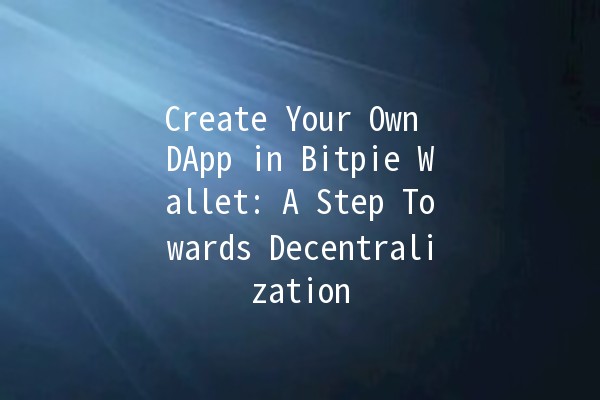
The blockchain space has been rapidly evolving, giving rise to various applications, including Decentralized Applications (DApps). These apps leverage blockchain technology to offer users greater security, transparency, and control over their digital assets. In this article, we will guide you through the process of creating your own DApp using Bitpie Wallet. By carefully exploring practical tips and strategies, you can enhance your productivity in this exciting venture.
Understanding DApps
What are DApps?
Decentralized Applications, or DApps, are applications that run on a blockchain network rather than a centralized server. This means they operate autonomously, allowing users to interact with smart contracts directly. DApps often utilize cryptocurrencies as their primary form of currency for transactions.

Why Create DApps in Bitpie Wallet?
Bitpie Wallet is an excellent platform for creating DApps due to its userfriendly interface and robust security features. It supports multiple blockchains, making it a versatile choice for developers. Additionally, Bitpie provides a seamless experience for integrating with various decentralized protocols.
Key Productivity Tips for Creating DApps
Creating a DApp can be intricate, but following these productivity tips can streamline your process and enhance your development efficiency.
Before diving into the technical aspects, take time to define the purpose and target audience of your DApp. A welldefined purpose aligns your development efforts and features, ensuring that you meet user needs effectively.
Example: If you want to create a DApp for digital identity verification, research existing solutions and identify gaps in the market that your application can fill.
Smart contracts are the backbone of any DApp. These are selfexecuting contracts with the terms of the agreement directly written into code. Spend time learning about the programming languages used in smart contracts, such as Solidity.
Example: Study existing smart contracts on platforms like Ethereum to understand how they function. You can replicate simple contracts to develop your skills.
Integrating development frameworks can significantly enhance your coding productivity. Tools like Truffle and Hardhat provide environments for writing, testing, and deploying smart contracts efficiently.
Example: Using Truffle Suite, you can set up a project, write smart contracts, and test them locally before deploying them on the blockchain.
Version control systems like Git help manage code changes effectively, especially in collaborative environments. This practice not only allows you to track progress but also resolves conflicts during collaboration.
Example: Use GitHub to store your project and collaborate with other developers. Make frequent commits so you can revert to previous versions if necessary.
Invest time in designing an intuitive user interface (UI) for your DApp. A welldesigned UI enhances user satisfaction and increases platform engagement.
Example: Conduct user testing sessions with potential customers to gather feedback on design elements. Use tools like Figma to create prototypes and refine them based on user insights.
Building Your DApp in Bitpie Wallet
Now that we've covered crucial productivity tips, let's discuss the steps to create and deploy your DApp using Bitpie Wallet.
Step 1: Setting Up Your Bitpie Wallet
Step 2: Choose the Blockchain
Bitpie supports various blockchains for DApp creation. Choose a blockchain that aligns with your application’s objectives:
Ethereum: Known for its smart contract functionality.
EOS: Focuses on scalability and speed.
Tron: Targeted towards high throughput.
Step 3: Create Your Smart Contract
Utilize your knowledge of smart contracts to code the functionalities required for your DApp. Implement features such as transactions, data storage, and user authentication.
Step 4: Deploy Your Smart Contract
Deploy your smart contract on the chosen blockchain using tools provided by your development framework. Once deployed, your DApp will be live and accessible to users.
Step 5: Integrate with Bitpie Wallet
Link your DApp with Bitpie Wallet by incorporating its API. This will allow users to interact with your DApp seamlessly using their Bitpie Wallets, enhancing user experience and engagement.
Step 6: Test Your DApp
Testing is crucial to identify and rectify potential issues before public launch. Conduct thorough testing of all functionalities and optimize performance.
Step 7: Launch and Promote Your DApp
After testing, launch your DApp and promote it across various platforms. Engage with your users on social media and blockchain forums to gather feedback and improve your service continually.
Frequently Asked Questions
To create a DApp, you typically need:
Basic understanding of blockchain technology
Knowledge of smart contract programming (e.g., Solidity)
Familiarity with DApp design principles
The cost can vary widely based on the blockchain you choose, the complexity of your DApp, and the gas fees associated with deployment. On Ethereum, deployment costs can range from a few dollars to hundreds depending on network congestion.
Yes, DApps can be updated, but changes to the smart contract code require deploying a new contract. Users may need to migrate to the updated version, depending on the changes made.
Security is paramount in the blockchain space. Implement thorough testing, code audits, and utilize best security practices to safeguard user data and funds.
Some common challenges include:
Complexity in coding and testing smart contracts
Balancing user experience with decentralized features
Navigating regulatory compliance based on your application’s functions
Effective marketing strategies involve:
Engaging with blockchain communities
Utilizing social media platforms for promotion
Offering incentives for early adopters
Creating a DApp in Bitpie Wallet represents an extraordinary opportunity to dive into the decentralized world. By following the outlined productivity tips and steps, you can efficiently harness blockchain technology to realize your vision. Embrace this journey of innovation and take the first step toward decentralization today!

